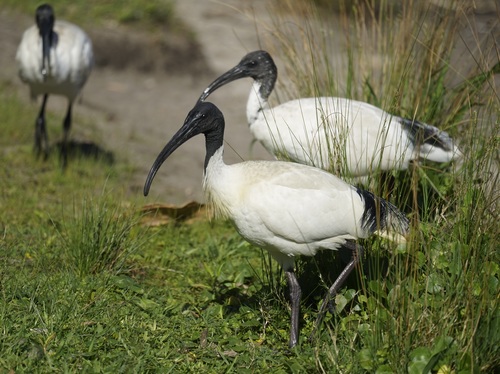
Australian White Ibis
The Australian White Ibis (*Threskiornis molucca*) is a wading bird native to Australia, easily recognizable by its distinctive down-curved bill and predominantly white plumage. Often seen in urban environments, it has adapted remarkably well to human presence, earning it nicknames like "bin chicken" or "tip turkey." Despite its sometimes-maligned status in urban areas, the Australian White Ibis plays a crucial role in controlling insect populations, particularly in agricultural settings. It also holds cultural significance for some Indigenous Australian groups, featuring in stories and traditions.
65-75 cm
Length
110-125 cm
Wingspan
Least Concern
Conservation Status
Distribution
Primarily found across Australia, with populations also in western Indonesia, and southern New Guinea. It is less common in arid regions of central Australia. They are considered a partially migratory species, with movements often driven by rainfall and food availability.
Lifespan
Up to 28 years in captivity, typically shorter in the wild (exact wild lifespan data is limited).
Australian White Ibis's Habitat
Habitat Types
Wetlands, Grasslands, Mudflats, Estuaries, Agricultural land, Urban parks and gardens
Climate Zones
Tropical, Subtropical, Temperate
Adaptations
Their long, curved bill is a specialized adaptation for probing in mud and shallow water to find prey. They also possess tactile receptors at the tip of their bill, helping them locate food by touch in murky conditions.
Variations
Two subspecies are generally recognized: *T. m. molucca* (found in Australia and New Guinea) and *T. m. strictipennis* (found in Indonesia). The differences are subtle, mainly relating to slight variations in plumage and size.
Appearance
Breeding Plumage
Breeding adults develop ornamental plumes on their neck and back. Non-breeding adults have a simpler, less ornate plumage.
Seasonal Feather Changes
Plumage variations are primarily linked to breeding status rather than seasonal changes.
Sex Based Plumage Differences
Minimal; males and females have similar plumage, although males may have slightly more developed ornamental plumes during breeding.
Notable Features
Long, down-curved black bill, Naked black head and neck, White body plumage, Black legs and feet, Reddish skin patch under the wing (visible in flight)
Diet and Feeding
Primary Foods
Crustaceans, Insects, Mollusks, Fish, Frogs, Earthworms, Human refuse (in urban areas)
Foraging Behavior
Probes mud and shallow water with its bill, using tactile sensitivity to locate prey. In urban areas, it readily scavenges for food scraps in bins and landfills.
Specializations
The curved bill and tactile receptors are key specializations for foraging in soft substrates.
Seasonal Diet Variations
Diet can vary depending on food availability. During dry periods, they may rely more on insects and less on aquatic prey.
Behavior
Social Structure
Highly social; often found in large flocks, especially during breeding season and at roosting sites.
Communication
Guttural croaks and grunts, Bill-clapping during courtship, Visual displays (e.g., bowing)
Migration
Partially migratory; movements are often driven by rainfall and food availability. Some populations are largely sedentary.
Territorial or Group Behaviors
Breeding colonies can be densely packed, with some degree of territorial defense around nest sites. Outside of breeding, they are generally non-territorial.
Conservation
Threats
Habitat loss and degradation (wetlands), Pesticide use, Disturbance at breeding colonies, Drought
Protection Programs
Wetland conservation and management initiatives, Monitoring of breeding colonies
Local National Laws
Protected under various state and national wildlife legislation in Australia.
Population Trend
Stable
Population Estimates
The global population is estimated to be in the hundreds of thousands, and it is considered a common species.
Interesting Facts
They are sometimes called the 'Sacred Ibis' in Australia, though they are a different species from the true Sacred Ibis of Africa.
This misnomer likely arose due to their similar appearance and ecological role.
They have adapted remarkably well to urban environments.
This adaptability has allowed them to thrive in areas where other native species have struggled.
They can play a role in controlling agricultural pests.
Their consumption of insects like grasshoppers and locusts can benefit farmers.
Faqs about Australian White Ibis
Why are Australian White Ibis so common in cities?
They are opportunistic feeders and have adapted to scavenging for food in urban environments, finding ample resources in landfills and parks.
Are Australian White Ibis aggressive?
They are generally not aggressive towards humans, but they can be bold in their pursuit of food.
Do Australian White Ibis migrate?
Some populations are partially migratory, moving in response to rainfall and food availability, while others are more sedentary.
Are they protected?
Yes, the Australian White Ibis is protected under legislation in all Australian states and territories.
Copyright @ Nature Style Limited. All Rights Reserved.
 English
English